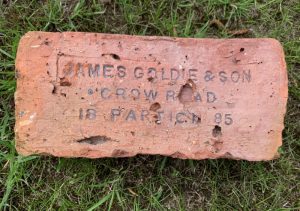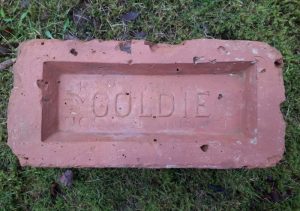Below are some notes sent to me by Stuart McLean with regards a dispute between Gichchrist and Goldie, Brick manufacturers and the North British Railway Company. I have not read the full article.
Precise of Gilchrist & Goldie Brickworks V North British Railway Company – 1869/72 – by Stuart McLean.
Claims for Pursuer:
1 . All the clay, subsoil and other materials in the field for the duration of 8 years from Whitsunday 1867 at the annual fixed rent of £150, subject to conditions, were let from Andrew Drummond Foulds by James Gordon Oswald.
2 . In March 1868 Gilchrist & Goldie purchased and acquired the rights to the field and brickworks and have worked the brickworks as owners since then.
3. The ground is 4 ½ acres and is suitable for the working of 4 tables. Half a million bricks are made per table per season therefore 2 million overall.
4. Two extra acres were bought to build brick making machinery. They bought an engine and boilers for this purpose, but the arrival of surveyors from the Railway Company led them to believe they would get only one season from the machines, so they postponed their erection.
5. They have had the engine and boilers for two years.
6. The Railway Company gave notice that to build the railway they would need 1 acre, 1 rod and 2 poles (0.33 of the field). On 2/10/1871 NBR took possession of the land.
7. The railway is 24’6” high running through the land in a diagonal curve. This renders the field too small and the value of the land will drop greatly.
8. The lease of the brickfield extends to the Whitsunday 1875 so there are 4 seasons of brick making unused.
9. The claimants (the brickfield) claim damages for loss and injury,
£
Levelling 100
Loss of profit on 1 000 000 bricks for 4 yrs 2 000
Loss and damage on remaining portion machinery, working
smaller field, severance of ground, general disturbance 500
+10% for compulsory purchase 260
2 860
Alternatively:- The number of bricks actually produced was 850 000. At 28/- per 1000 this equals – £1260/10
Costs:
Raising clay, moulding and dyking bricks. 371
Setting bricks 109/5
Rent & taxes 80
430 tons coal @ 7/6 161/5
Sand, ashes and clash 30
Wages 20
Water charge 7/16
779/15
Profit per annum = £489
The other claimant’s income for the remainder of lease is £1956,
Other claims as before = £860
Therefore £2816
Answers for North British Railway:
1. Admitted.
2. Admitted.
3. Admitted that the field is 4 1/2 acres, that it may be worked in 4 tables, and the usual number of bricks per table is 1/2m. Not admitted that claimants always worked 4 tables.
4. Not known or admitted.
5. Denied. Engine and boiler referred to formed part of the plant.
6. Admitted NBR took possession of the ground as stated in 4/5/1871.
7. Admitted that proposed railway will run through the field but will not take off as much as a third.
8. Admitted.
9. Denied that entitled to compensation. Amounts are excessive. Price of £1000 per ton is too high
Findings of oversman:- £1138 to claimants + interest of 5% pa from the date of the decree. Claimants will also be entitled to an apportionment of fixed rent Also entitled to expenses of the action
Dated 5 March 1872







